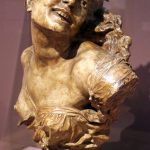Hector Caffieri, born on September 19, 1847, in London, left an indelible mark on the world of sculpture during the late 19th and early 20th centuries. Renowned for his mastery in working with bronze, Caffieri’s artistic journey unfolded against the backdrop of a dynamic period in art history marked by shifts in style and a growing appreciation for the decorative arts.
Early Artistic Aspirations
Caffieri’s early years were steeped in artistic influence, with his family’s roots tracing back to a long line of accomplished sculptors. Raised in an environment that nurtured creativity, he developed an early fascination with the sculptural form. His formal training began at the Lambeth School of Art, where he honed his skills and embraced the classical traditions of sculpture.
As a young artist, Caffieri demonstrated a predilection for working with bronze—a material that would become synonymous with his name. His early pieces hinted at a sculptor with a keen eye for detail and an innate ability to infuse life into inanimate forms. Caffieri’s dedication to his craft was evident, and he soon gained recognition for his technical proficiency and artistic vision.
Pioneering Decorative Arts
The latter half of the 19th century witnessed a revival of interest in the decorative arts, and Caffieri emerged as a pioneer in the field. His sculptures seamlessly blended classical elegance with a contemporary sensibility, earning him acclaim in artistic circles and among patrons of the decorative arts. Caffieri’s works adorned interiors, contributing to the ornamental richness of the Victorian and Edwardian eras.
Notable among his early successes was his collaboration with the renowned furniture designer Edward William Godwin. The partnership resulted in exquisite bronze embellishments for Godwin’s furniture pieces, showcasing Caffieri’s ability to harmonize sculpture with functional design. This foray into the decorative arts marked a significant chapter in his career and underscored the versatility of his talent.
Royal Patronage and Prestige
Caffieri’s reputation continued to ascend, leading to commissions from distinguished patrons, including members of the royal family. His skill in capturing the likeness and character of his subjects garnered him royal favor, and he received prestigious commissions such as the creation of a bronze memorial to Queen Victoria’s late husband, Prince Albert. This monumental work solidified Caffieri’s status as a sculptor of national importance.
The sculptor’s ability to translate the regal into tangible bronze masterpieces extended beyond memorials. His royal commissions included busts and statues that adorned palaces and public spaces, leaving an enduring legacy of his contribution to the visual narrative of the British monarchy.
Technological Innovation and Legacy
Caffieri’s embrace of technological advancements in the late 19th century further distinguished his work. The advent of new casting techniques allowed him to push the boundaries of bronze sculpture, achieving levels of detail and intricacy previously unimaginable. This commitment to innovation not only enhanced the aesthetic appeal of his pieces but also contributed to the evolution of bronze sculpture as a medium.
The legacy of Hector Caffieri endures through his numerous public and private works that grace museums, galleries, and stately homes. His sculptures, characterized by their grace and sophistication, serve as a testament to his ability to capture the essence of his subjects. The enduring appeal of Caffieri’s art lies in its ability to transcend temporal boundaries, resonating with admirers of sculpture and decorative arts alike.
Hector Caffieri passed away on December 10, 1932, leaving behind a legacy that extends far beyond his lifetime. His contributions to the world of bronze sculpture and the decorative arts have secured his place as a distinguished figure in the annals of art history. Caffieri’s dedication to his craft, innovative spirit, and artistic vision continue to inspire sculptors and art enthusiasts, ensuring that his name remains synonymous with the timeless elegance of bronze sculpture.




